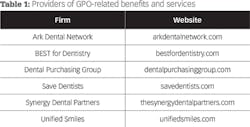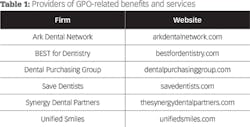The Dental Drilldown: Dental group purchasing organizations 101
Alex Sadusky
In today’s competitive dental industry, independent practitioners are looking for any type of edge they can find. Why? Because of the ever-present difficulties of running a productive and profitable practice in today’s competitive environment. There are the decreasing reimbursements from PPOs, as well as the complicated and continually evolving tax laws—not to mention the challenge of attracting new patients, who are more informed and selective than ever before when choosing a dentist.
Even worse, the very presence of these difficulties has largely contributed to the emergence of an appealing alternative to independent practice: the dental service organization (DSO).
The rise of DSOs shouldn’t come as too much of a surprise. After all, DSOs offer attractive benefits to doctors. For example, DSOs offer the ability to be hands-off on nonclinical responsibilities, stable work hours, clinical education support, and the elimination of stress caused by running a small business. In addition, DSOs are often very well capitalized and can make long-term investments and leverage their scale.
Today’s graduating dentists are faced with a tough choice: First, with the continued rise in the cost of a dental education and the increasing costs in starting a practice (driven largely by today’s technological demands), dentists face no small hurdle in starting a practice. Second, graduating dentists could associate in an existing practice and plan to acquire a new practice. Given the prevalence of DSOs, their ability to extract value above and beyond the independent practitioner, and their low-cost capital base, DSOs can often outbid independent practitioners when buying a practice.
But what about those dentists who still want their own practices, even in the face of these challenges? Yes, running a business is hard. However, the ability to have total freedom and control to build a practice in their own vision is a dream come true for many dentists. They not only own their practices but also the ongoing relationships with patients that keep their practices thriving.
Independent practices don’t need to be forced out of what they want to accomplish because of the rise of these larger, more well-funded organizations. They just need help gaining some of the same competitive advantages on the business side of things. That’s where group purchasing organizations (GPOs) come in.
GPOs help independent practice owners create a more level playing field by giving them access to the benefits of operating at a large scale. GPOs achieve this by brokering deals and negotiating special pricing with suppliers and manufacturers on behalf of their members—meaning the independent practice members can often leverage purchasing economies and bulk discounts comparable to those of DSOs. Additionally, some GPOs work with service providers that can lend a hand with nonclinical functions.
Proven track record
It appears to be the perfect time for GPOs to emerge in the dental industry so independent practices can start reaping the benefits. And why not? Clinicians from other medical industries, such as optometry and veterinary, have been leveraging the power of GPOs for a while now, so the template for success is already there.
Plus, it’s not uncommon for health-care businesses to use multiple groups. For instance, given the wide array of products and vendors hospitals need to use, it typically behooves them to belong to two or three GPOs (not necessary in dental, as the larger GPOs have broad enough coverage).
The cost savings can be significant. In fact, according to a report published by the Healthcare Supply Chain Association, health-care companies claim GPOs save them 10% to 18% on supplies and services.1
Dental GPOs
The good news for independent dental practices is that numerous GPOs exist in the dental industry already. They can differ in areas, such as the cost of membership and the range of services they provide, so dentists who are considering joining a GPO will have some options and can choose based on what will work best for the specific needs of their practices. Here’s a brief rundown of some areas where dental GPOs can contrast in approach.
Cost of membership—Some GPOs offer free membership, while others require monthly or yearly dues. Some offer both options. For example, a practice can either join at the basic level, usually free, or at a premium level with more access and privileges. Additionally, some GPOs with paid memberships offer free trial periods, typically for 45–60 days.
Practice owners will want to do their homework before ultimately deciding which GPO membership structure is best for them. It may not necessarily be the one with free membership.
Source of revenue—GPOs typically make their money through administrative or marketing fees charged to their vendor partners, membership fees, or a combination of both. Those that do charge membership fees might have the ability to pass along more savings or attain better pricing for their members. This is because they can afford to charge their vendor partners less in fees, and in turn, their vendor partners can afford to offer deeper discount pricing to the group members. It is always a balance between maximizing vendor rebates (marketing fees) and passing the lowest cost to the practitioner. Additionally, there are GPOs that will take commissions based on the level of savings achieved by their members, with the thought being that their results are directly tied to the members’ results. Again, dental practices will need to evaluate the different options to decide which works best for them.
Redemption of discounts—The majority of the dental GPOs pass the savings along to their members seamlessly. For example, upon joining, members typically have instant access to the discounted pricing that was prenegotiated by the GPO with their vendor partners. This makes it easy for members to know they’re receiving the discounts, as opposed to paying regular prices and waiting to receive the savings through rebates or credits.
Range of services offered—The cornerstone offering of most GPOs is the prenegotiated special pricing on merchandise, sundries, equipment, and lab services. However, some GPOs also partner with companies that offer other types of services at discounted rates. This can include anything from practice management and marketing to IT and payroll services. Plus, some GPOs will offer deals on services that can be attractive to the entire staff, such as cell phone plans.
Analysis and reporting—The amount practices can save by belonging to GPOs will vary based on factors such as size and purchasing habits, as well as the competitiveness of their current supply chain and support infrastructure. However, some GPOs offer a complimentary analysis of current supplier invoices. This allows practices to compare prices and get a solid idea of how much they can save prior to joining. Also, some GPOs provide reports that help track savings and purchasing trends during membership, which can help members identify the optimal mix of products and services to source through the GPO.
Getting started
The groups in Table 1 offer GPO-related benefits and services. Two of the larger GPOs, Synergy Dental Partners and Unified Smiles, state on their sites that they are committed to helping preserve the independent dental practitioner. They are also founded and operated by dentists, which has a lot of appeal to doctors across the nation. While this is not an exhaustive list, it is a great place to start, should you have interest in exploring GPOs further.
Reference
1. O’Brien D, Leibowitz J, Anello R. Group purchasing organizations: How GPOs reduce healthcare costs and why changing their funding mechanism would raise costs. Healthcare Supply Chain Association website. https://www.supplychainassociation.org/wp-content/uploads/2018/05/Leibowitz_GPO_Report.pdf. Published June 2017. Accessed August 2, 2018.
Alex Saduskycurrently serves as the chief executive officer of Dental Card Services Alliance LLC (dentalcardservices.com), an organization he cofounded in 2009. Dental Card Services Alliance is the exclusive credit card processing services provider of the Academy of General Dentistry Exclusive Benefits program and has numerous other endorsements, alliances, and associations.
Editor’s note:
This is part two in a three-part series. The next installment will appear in the October issue of Dental Economics.


